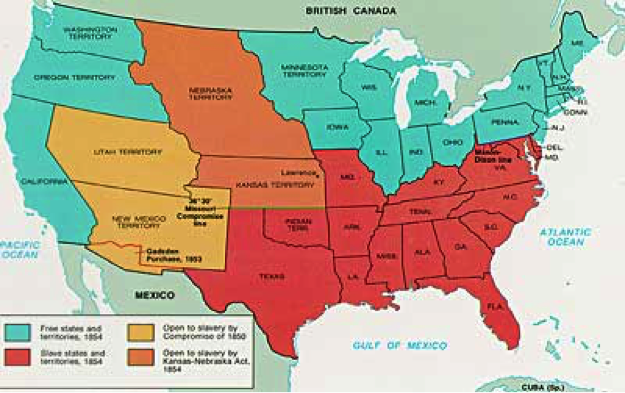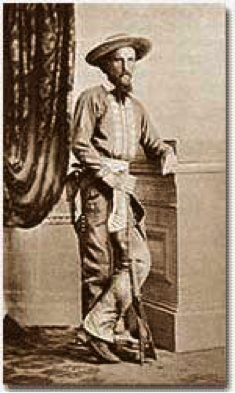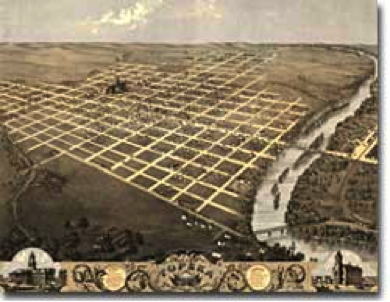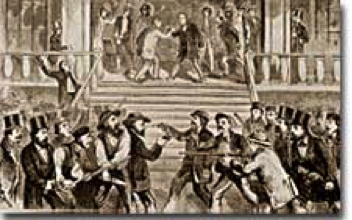by the Independence Hall Association

Stephen Douglas, sponsor of the Kansas-Nebraska Act and the most vocal supporter of “popular sovereignty,” was known as the “Little Giant” because of his small stature.
The KANSAS-NEBRASKA ACT OF 1854 may have been the single most significant event leading to the Civil War. By the early 1850s, settlers and entrepreneurs wanted to move into the area now known as Nebraska. However, until the area was organized as a territory, settlers would not move there because they could not legally hold a claim on the land. The southern states’ representatives in Congress were in no hurry to permit a Nebraska territory because the land lay north of the 36°30′ parallel—where slavery had been outlawed by the Missouri Compromise of 1820. Just when things between the North and South were in an uneasy balance, Kansas and Nebraska opened fresh wounds.

A major Southern political victory, the Kansas-Nebraska Act (1854) sparked the birth of the Republican Party and began a chain of events in the Kansas Territory that foreshadowed the Civil War.
Senator Stephen Douglas (D-IL) said he wanted to see Nebraska made into a territory and to win southern support proposed a pro-southern state inclined to support slavery—Kansas. Underlying it all was his desire to build a transcontinental railroad to go through Chicago. The Kansas-Nebraska Act allowed each territory to decide the issue of slavery on the basis of “popular sovereignty,” which meant that the inhabitants of the territory themselves, not the US Congress, would determine the slave status of the soon-to-be-admitted state.
Kansas with slavery would violate the Missouri Compromise, which had kept the Union from falling apart for the last thirty-four years. So, the long-standing agreement would have to be repealed. Opposition was intense, but ultimately the bill passed in May of 1854. Territory north of the sacred 36°30′ line was now open to popular sovereignty. The North was outraged.

The Kansas-Nebraska act made it possible for the Kansas and Nebraska territories (shown in orange) to open to slavery. The Missouri Compromise had prevented this from happening since 1820.
The political effects of Douglas’ bill were enormous. Passage of the bill irrevocably split the Whig Party, one of the two major political parties in the country at the time. Every northern Whig had opposed the bill; almost every southern Whig voted for it. With the emotional issue of slavery involved, there was no way a common ground could be found. Most of the southern Whigs soon were swept into the Democratic Party. Northern Whigs reorganized themselves with other non-slavery interests to become the REPUBLICAN PARTY, the party of Abraham Lincoln. This left the Democratic Party as the sole remaining institution that crossed sectional lines. Animosity between the North and South was again on the rise. The North felt that if the Compromise of 1820 was ignored, the Compromise of 1850 could be ignored as well. Violations of the hated Fugitive Slave Law increased. Trouble was indeed back with a vengeance.
Border Ruffians

Border Ruffian R.H. Wilson fought against the Free Soilers in Kansas and eventually joined the Confederate Army.
The passage of the Kansas-Nebraska Act would lead to a civil war between pro-slavery and anti-slavery settlers in Kansas.
Slavery was quite likely to be outlawed in Nebraska, where cotton did not grow well. The situation in Kansas was entirely different, where the land was similar to Missouri’s, which was a slave state. Kansas was to be governed by the principle of popular sovereignty. Whether Kansas was to be slave or free would be decided at the polls. Both free and slave forces were determined to hold sway.
Missouri counties that bordered Kansas were strongly pro-slavery and wanted their neighbor to be a slave state. In the fall of 1854, Senator David Atchinson (D-MO) led over 1,700 men from Missouri into Kansas to vote for their pro-slavery representative. These were the infamous “BORDER RUFFIANS,” who threatened to shoot, burn and hang those opposed to slavery.

The city of Topeka, shown here on a panoramic map from 1869, housed the Free Soil Kansas legislature.
Although their votes were later ruled fraudulent, their candidate was elected to Congress. When it came time to elect a territorial legislature the following March, almost 5,000 men came into the state from Missouri to cast illegal ballots. Pro-slavery forces had the numbers, not the ethics, on their side. Anti-slavery settlers, though the majority in Kansas, were outvoted. The result of the election through fraud was a legislature with 36 pro-slavery delegates and 3 anti-slavery delegates.

The violence at Fort Scott, Kansas, led the governor to call for a peace convention on June 15, 1858. The meeting broke out into a riot.
As one of their first acts, this legislature passed a harsh slave code that provided fines and imprisonment simply for expressing opinions against slavery. The death penalty would be administered to any individual found guilty of assisting slaves to revolt or escape. It also legalized the “border ruffian” vote by not requiring voters to be residents in Kansas prior to voting and made the law retroactive to the preceding elections.
Within a year, the population of anti-slavery residents in Kansas far outnumbered legal residents of Kansas who were pro-slavery. They were not prepared to obey the laws of the “BOGUS LEGISLATURE,” seated in SHAWNEE MISSION. Organized under the name of FREE SOILERS, they drew up a free state constitution and elected a separate governor and state legislature located in Topeka. The result was a state with two governments. Widespread violence erupted that would last until well into the Civil War.
